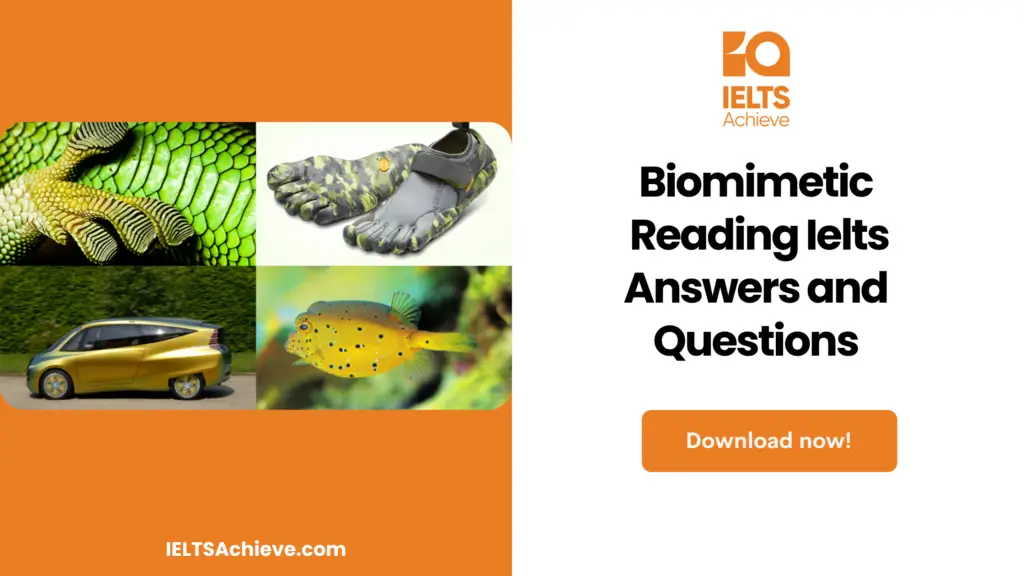The Blog post contains the following IELTS Reading Questions:
- IELTS Reading True/False/Not given
- IELTS Reading Sentence Completion
- IELTS Reading Note Completion

IELTS reading passage – Biomimetic Design
Biomimetic Design
“Its back is completely drenched!” The lizard’s leg had been scooped up by the water in the dish after 30 seconds, and it now had a glistening coating over its prickly hide. The water eventually entered its mouth, and the lizard started to slap its jaws in apparent enjoyment and satisfaction as soon as that happened. In essence, it was drinking from its foot. If the thorny devil has more time, he can execute the same conjuring trick on a damp patch of sand– giving him a crucial competitive edge in the desert. Parker had come here to find out exactly how it achieves this, not just for biological reasons but also with a specific goal in mind: to create a technology that is inspired by thorny devils and will aid people in gathering life-sustaining water in the desert. Drops from his eyedropper landed upon the lizard’s back and disappeared like a magic as he remarked, “The water’s spreading out unbelievably rapidly!”, he said.” Its skin is much less hydrophobic than I had anticipated. there may be capillaries hidden from view that direct water to the mouth”.
The global biomimetics movement is getting more and more active, and Parker’s work is just one small piece of it. To create more agile aeroplane wings, engineers in Bath, England, and West Chester, Pennsylvania, is studying the bumps on the leading edges of humpback whale flukes. Engineers in Berlin, Germany, are being inspired by the raptors’ finger-like primary feathers to create wings that change shape in the air to minimise drag and boost fuel efficiency. To design more comfortable buildings, Zimbabwean architects are studying how termites control temperature, humidity, and airflow in their mounds. Meanwhile, Japanese medical researchers are developing hypodermic needles with tiny serrations, similar to those on a mosquito’s proboscis, to lessen the pain of injections by reducing nerve stimulation.
Ronald Fearing, an electrical engineering professor at the University of California, Berkeley, has taken on one of the most difficult tasks of all: developing a miniature robotic fly that is fast, compact, and manoeuvrable enough for surveillance or search-and-rescue missions. Fearing created his own, one of which he held out with tweezers for me to see. It was an 11-millimetre-long, barely-thickened-cat-whisker-sized gossamer wand. Fearing is required to utilise a micromachining laser and a rapid prototyping system to design miniature pieces of his fly in the same way, have them automatically cut and cured overnight, and then manually assemble them under a microscope the next day.
He uses a micro laser to carve the fly’s wings from a two-micron polyester sheet that is so thin that it needs to be reinforced with carbon fibre spars to stabilise it and crumples if you breathe on it. His most recent design has wings that flap 275 times per second, which is quicker than the blowfly’s rate of motion and produces the characteristic buzz. With a hint of self-satisfaction, he declared, “Carbon fibre outperforms fly chitin.”, said, with a trace of self-satisfaction. The fly-bot itself, a fragile, origami-like framework of black carbon-fibre struts and hairlike wires that, unsurprisingly, looks nothing like a genuine fly, was confined in a protective plastic box that was visible on the lab bench. One month later it successfully lifted off in a controlled flight on a boom. Fearing anticipates the fly-bot hovering in two to three years and eventually doing virtuosic bank and dive manoeuvres.
Mark Cutkosky, a roboticist at Stanford University, created Stickybot, a gecko-insured climber. Gecko feet are dry and smooth to the touch, not sticky, and they owe their extraordinary adhesion to the two billion spatula-tipped filaments that cover each square centimetre of their toe pads, each filament is only 100 nanometers thick. These filaments are so small that they interact with the gecko’s walking surface at the molecular level. They do this by utilising low-level van der Waals forces, which are produced by molecules’ transient positive and negative charges and draw any two adjacent objects together. Cutkosky and doctoral student Sangbae Kim, the robot’s principal designer, created a urethane cloth with minuscule bristles that end in 30-micrometre points to build the toe pads for Stickybot. They support the 500-gram robot on a vertical surface, however, they are not as flexible or adhesive as the gecko itself.
Cutkosky endowed his robot gecko-like feet that squeak against the wall and seven-segment toes that pull and release like a lizard’s. To achieve the same smooth transition from stiff to flexible that is present in the lizard’s limbs and absent in most man-made materials, he also used a technique he calls shape deposition manufacturing (SDM) to make Stickybot’s legs and feet. Additionally, SDM enables him to incorporate sensors, actuators, and other specialised structures that will improve Stickybot’s climbing abilities. Then, he discovered in an article on the anatomy of geckos that the lizard needed to branch tendons to evenly distribute its weight across the surface of each of its toes. Eureka.”Wow, that’s incredible,” I thought upon seeing it. To evenly disperse the strain on his robot’s limbs, he implanted a branching polyester “tendon” into each of its limbs.
Although it will take some time before Stickybot can keep up with a gecko, it can now climb vertical surfaces made of glass, plastic, and glazed ceramic tile. Its current walking pace, which is barely four centimetres per second and is much slower than that of its biological role model, is limited to smooth surfaces. Stickybot’s dry adhesive quickly becomes clogged with dirt because it isn’t self-cleaning as the lizard is. Cutkosky claims that “there are many things about the gecko that we simply had to disregard.” Nonetheless, there are several real-world applications on the horizon. An automaton that might slink up a building and hang there for hours or days, studying the terrain below, is what the Defense Advanced Research Projects Agency (DARPA), which finances the research, has in mind for surveillance. Cutkosky suggests a variety of non-military applications.” I’m trying to get robots to travel to places they’ve never been before,” he added. Whether it’s a toy or another application, I’d like Stickybot to have real-world use. It would be fantastic if one day it could lifesaving or assist others.
Despite the strength of the biomimetics paradigm and the intelligent individuals who apply it, only one widely recognised product—Velcro—has been made using bio-inspiration, which was created in 1948 by Swiss chemist George de Mestral after observing how cockleburs stuck to his dog’s coat. In addition to Cutkosky’s lab, five other top-tier research teams are currently attempting to duplicate gecko adhesion, but none of them has been able to equal the lizard’s powerful, directed self-cleaning grasp. Similar to how several well-funded biotech companies failed in their attempts to produce synthetic spider silk, scientists have yet to meaningfully replicate the abalone nanostructure that accounts for the resilience of its shell.
Biomimetic Design reading questions
Questions 1 – 3
Fill in the blanks below. Write NO MORE THAN THREE WORDS AND/OR A NUMBER from the passage for each answer about facts of stickybot.
Stickybot can only move across smooth surfaces because its feet lack the 1)………………function. Stickybot will be used by DARPA for 2)………………. Cutkosky believes that stickybot has the potential to participate in 3)……………… or other human-related activities.
Enhance your sentence completion skills in the IELTS Reading section. Click here to access our comprehensive guide and learn effective strategies for filling in missing words or phrases in sentences.
Questions 4 – 6
Fill in the blanks below. Use NO MORE THAN THREE WORDS from the Reading Passage for each answer.Write your answers in boxes 4-6 on your answer sheet.
- Ronald Fearing was required to fabricate tiny components for his robotic fly 4)……………………by specialised techniques.
- The robotic fly’s main structure outside is made of 5) …………………… and long and thin wires which make it unlike a fly at all.
- Cutkosky applied an artificial material in Stickybot 6) …………………… as a tendon to split pressure as a lizard does.
Boost your performance in Summary, Notes, Table, and Flowchart Completion tasks. Click here to explore our detailed guide and learn how to effectively complete summaries, notes, tables, and flowcharts in the IELTS Reading section.
Questions 7 – 13
Do the following statements agree with the information given in the Biomimetic Reading Passage ? For the questions 7 – 13 on your answer sheet write
TRUE if the statement agrees with the information
FALSE if the statement contradicts the information
NOT GIVEN if there is no information on this
7. As a gecko descends, its feet secrete a substance that renders them adhesive.
8. The gecko’s ability to adhere to a surface is facilitated by the tiny and thin hairs on its feet.
9. Andrew Parker was unable to create a functional water device that could be employed in arid environments.
10. When lizard skin comes into contact with water, it is easily moistened.
11. Many artificial engineering innovations by scientists are inspired by nature.
12. Famous cases stimulate a large number of successful products of biomimetics in real life.
13. Velcro is well known for its bionics design.
Enhance your skills in identifying information as True, False, or Not Given. Click here to discover expert strategies and techniques for mastering this question type in the IELTS Reading section.
Unlock your full potential in the IELTS Reading section – Visit our IELTS Reading Practice Question Answer page now!
Recommended Questions:
Renewable Energy IELTS Reading Question with Answer
Biomimetic reading answers
| 1. Self-cleaning | 5. Carbon fibre | 9. Not given | 13. True |
| 2. surveillance | 6. limbs/legs/feet | 10. False | |
| 3. lifesaving | 7. Not given | 11. True | |
| 4. The same way | 8.False | 12. False |

We hope you found this post useful in helping you to study for the IELTS Test. If you have any questions please let us know in the comments below or on the Facebook page.
The best way to keep up to date with posts like this is to like us on Facebook, then follow us on Instagram and Pinterest. If you need help preparing for the IELTS Test, join the IELTS Achieve Academy and see how we can assist you to achieve your desired band score. We offer an essay correction service, mock exams and online courses.

